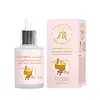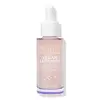What's inside
What's inside
 Key Ingredients
Key Ingredients

 Benefits
Benefits

 Concerns
Concerns

 Ingredients Side-by-side
Ingredients Side-by-side

Oryza Sativa Bran Water
MaskingAvena Sativa Kernel Extract
AbrasiveSqualane
EmollientPropanediol
SolventGlycerin
HumectantDimethyl Sulfone
SolventCaprylic/Capric Triglyceride
MaskingWater
Skin ConditioningButylene Glycol
HumectantAvena Sativa Kernel Oil
Skin ConditioningLinum Usitatissimum Seed Oil
PerfumingCentella Asiatica Extract
CleansingGlycine Max Oil
EmollientPanthenol
Skin ConditioningBetaine
HumectantPolyglyceryl-6 Stearate
EmollientGlyceryl Stearate
EmollientCorylus Avellana Seed Oil
EmollientCetearyl Alcohol
EmollientCeramide Ng
Skin ConditioningHelianthus Annuus Seed Oil
EmollientCamellia Sinensis Leaf Extract
AntimicrobialRosmarinus Officinalis Leaf Extract
AntimicrobialChamomilla Recutita Flower Extract
MaskingArginine
MaskingTocopheryl Acetate
AntioxidantCetyl Palmitate
EmollientSorbitan Palmitate
EmulsifyingCaprylyl Glycol
EmollientScutellaria Baicalensis Root Extract
AstringentGlycyrrhiza Glabra Root Extract
BleachingCaprylhydroxamic Acid
Zanthoxylum Piperitum Fruit Extract
Skin ConditioningPolyglyceryl-6 Behenate
Emulsion StabilisingCarbomer
Emulsion StabilisingPulsatilla Koreana Extract
Skin ConditioningSorbitan Olivate
EmulsifyingXanthan Gum
EmulsifyingUsnea Barbata Extract
Polygonum Cuspidatum Root Extract
AntioxidantMelaleuca Alternifolia Leaf Oil
AntioxidantCitrus Aurantium Bergamia Leaf Oil
AstringentCedrus Atlantica Bark Oil
MaskingOryza Sativa Bran Water, Avena Sativa Kernel Extract, Squalane, Propanediol, Glycerin, Dimethyl Sulfone, Caprylic/Capric Triglyceride, Water, Butylene Glycol, Avena Sativa Kernel Oil, Linum Usitatissimum Seed Oil, Centella Asiatica Extract, Glycine Max Oil, Panthenol, Betaine, Polyglyceryl-6 Stearate, Glyceryl Stearate, Corylus Avellana Seed Oil, Cetearyl Alcohol, Ceramide Ng, Helianthus Annuus Seed Oil, Camellia Sinensis Leaf Extract, Rosmarinus Officinalis Leaf Extract, Chamomilla Recutita Flower Extract, Arginine, Tocopheryl Acetate, Cetyl Palmitate, Sorbitan Palmitate, Caprylyl Glycol, Scutellaria Baicalensis Root Extract, Glycyrrhiza Glabra Root Extract, Caprylhydroxamic Acid, Zanthoxylum Piperitum Fruit Extract, Polyglyceryl-6 Behenate, Carbomer, Pulsatilla Koreana Extract, Sorbitan Olivate, Xanthan Gum, Usnea Barbata Extract, Polygonum Cuspidatum Root Extract, Melaleuca Alternifolia Leaf Oil, Citrus Aurantium Bergamia Leaf Oil, Cedrus Atlantica Bark Oil
Carthamus Tinctorius Seed Oil
MaskingCaprylic/Capric Triglyceride
MaskingHelianthus Annuus Seed Oil
EmollientSimmondsia Chinensis Seed Oil
EmollientAvena Sativa Kernel Oil
Skin ConditioningSorbitan Oleate
EmulsifyingCeramide NP
Skin ConditioningCeramide AP
Skin ConditioningCeramide EOP
Skin ConditioningAlthaea Officinalis Leaf/Root Extract
EmollientCalendula Officinalis Flower Extract
MaskingRosmarinus Officinalis Leaf Extract
AntimicrobialPhytosphingosine
Skin ConditioningLinoleic Acid
CleansingPhytosterols
Skin ConditioningPhospholipids
Skin ConditioningSodium Lauroyl Lactylate
EmulsifyingCholesterol
EmollientCarbomer
Emulsion StabilisingXanthan Gum
EmulsifyingPropanediol
SolventPhenoxyethanol
PreservativeEthylhexylglycerin
Skin ConditioningCarthamus Tinctorius Seed Oil, Caprylic/Capric Triglyceride, Helianthus Annuus Seed Oil, Simmondsia Chinensis Seed Oil, Avena Sativa Kernel Oil, Sorbitan Oleate, Ceramide NP, Ceramide AP, Ceramide EOP, Althaea Officinalis Leaf/Root Extract, Calendula Officinalis Flower Extract, Rosmarinus Officinalis Leaf Extract, Phytosphingosine, Linoleic Acid, Phytosterols, Phospholipids, Sodium Lauroyl Lactylate, Cholesterol, Carbomer, Xanthan Gum, Propanediol, Phenoxyethanol, Ethylhexylglycerin
 Reviews
Reviews

Alternatives
Ingredients Explained
These ingredients are found in both products.
Ingredients higher up in an ingredient list are typically present in a larger amount.
Avena Sativa Kernel Oil is the oil from colloidal oatmeal.
Besides being a healthy breakfast, oats have many benefits in skincare too.
Colloidal Oatmeal helps sooth, hydrate, and protect the skin. The starches in colloidal oatmeal are able to bind water, keeping the skin hydrated.
Avena Sativa Kernel Oil is also an antioxidant. Antioxidants help stabilize free-radical molecules. These molecules may damage skin cells.
Overall,Avena Sativa Kernel Oil is great at providing the skin with moisture. It also protects the skin as an antioxidant.
Learn more about Avena Sativa Kernel OilThis ingredient is an emollient, solvent, and texture enhancer. It is considered a skin-softener by helping the skin prevent moisture loss.
It helps thicken a product's formula and makes it easier to spread by dissolving clumping compounds.
Caprylic Triglyceride is made by combining glycerin with coconut oil, forming a clear liquid.
While there is an assumption Caprylic Triglyceride can clog pores due to it being derived from coconut oil, there is no research supporting this.
Learn more about Caprylic/Capric TriglycerideCarbomer is a polymer of acrylic acid. Its main role is to create a gel consistency.
A high amount of carbomer can cause pilling or balling up of products. Don't worry, most products contain 1% or less of carbomer.
Helianthus Annuus Seed Oil is the oil derived from the seeds of a Sunflower. Sunflower seed oil is non-fragrant. It is an emollient, meaning it helps to soften the skin.
Sunflower seed oil contains many fatty acids. The fatty acids found in sunflower seeds include (from highest amount to least): linoleic acid, myristic acid, palmitic acid, stearic acid, arachidic acid, oleic acid, and linolenic acid.
These fatty acids help the skin create ceramides. Ceramides play a role in repairing the skin barrier.
Helianthus Annuus Seed Oil helps moisturize the skin. This in turn helps the skin look more rejuvenated and smoother.
Sunflowers are rich in vitamin E.
Historians believe Indigenous cultures of North America domesticated sunflowers before corn. Thus they relied on sunflower oil for a variety of uses. One such use is moisturizing skin and hair.
Sunflower seed oil may not be fungal acne safe. We recommend speaking with a professional if you have any concerns.
Learn more about Helianthus Annuus Seed OilPropanediol is an all-star ingredient. It softens, hydrates, and smooths the skin.
It’s often used to:
Propanediol is not likely to cause sensitivity and considered safe to use. It is derived from corn or petroleum with a clear color and no scent.
Learn more about PropanediolRosmarinus Officinalis Leaf Extract comes from rosemary. Rosemary is native to the Mediterranean.
While Rosmarinus Officinalis Leaf Oil can be volatile due to its fragrant properties, the fragrance components are usually removed in the leaf extract.
Rosemary Leaf Extract contains many antioxidants such as rosmarinic acid and caffeic acid. Rosemarinic acid, a compound found in rosemary leaf, has been found to help soothe skin conditions such as eczema and acne.
Learn more about Rosmarinus Officinalis Leaf ExtractXanthan gum is used as a stabilizer and thickener within cosmetic products. It helps give products a sticky, thick feeling - preventing them from being too runny.
On the technical side of things, xanthan gum is a polysaccharide - a combination consisting of multiple sugar molecules bonded together.
Xanthan gum is a pretty common and great ingredient. It is a natural, non-toxic, non-irritating ingredient that is also commonly used in food products.
Learn more about Xanthan Gum